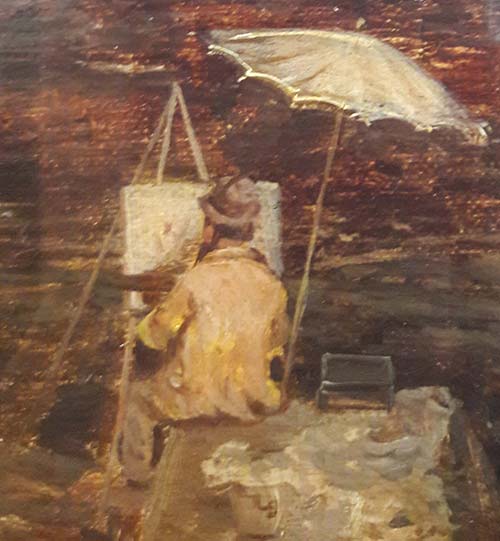Local History Society Report
A Victorian Artist Paints Hebden Bridge
Discovering the landscape paintings of John Holland. Report of talk by Diana Monahan and Justine Wyatt
Thursday, 9 January 2020
When Diana Monahan and Justine Wyatt, both active members of Hebden Bridge Local History Society and experienced researchers, decided to find out more about the Victorian artist John Holland’s paintings of the Calder Valley, they couldn’t know how the quest would come to absorb them.
As Justine told the society at the first meeting of 2020, John Holland was not a well known painter, but one of many artists enabled to get out into the landscape and paint from nature - by the invention of the paint tubes. This coincided with a fashion for the romantic, and a large new clientele of people who could afford to be patrons of the arts – including the wealthy textile manufacturers of Hebden Bridge and Todmorden.

John Holland was born in 1829 as the son of a Nottingham sign painter. It seems he developed his talents by copying works while assisting his father. He became part of a group of artists in Nottingham and in the 1850s exhibited his paintings of ‘everyday life’. There are records of paintings made by him of landscapes throughout Britain. In 1867 he came to the Calder Valley drawn ‘to study nature’ by the romantic crags and precipices and perhaps also by the new rich who might be persuaded to purchase his landscapes. In two years Holland produced over sixty paintings which were exhibited, and sold, at the White Horse in Hebden Bridge.
Though not an eminent artist, John Holland seems to have been quite successful. He moved to London in the 1870s and made his fortune. Later he bought a grand house near Tintagel in Cornwall, where he died in 1886. His paintings were praised for their fidelity, and a supporter, writing in the Todmorden papers to defend him against the slur that his paintings were ‘mere daubs’ because he completed them so quickly, asserted that ‘no gentleman should be ashamed’ to have one of his pictures hanging in his home.
Some of Holland’s paintings are at Bankfield Museum, though many more of his landscapes have disappeared, probably in private hands. In the Calder Valley he searched out ‘the choicest bits of scenery’ and if the scene included a new mill or the home of a wealthy potential patron, so much the better. The exhibition at the White Horse was advertised in the local press and the names of the pictures and their purchasers were listed. These included paintings of Cragg Valley, Todmorden Valley from Charlestown, Lumb Bridge and Falls at Crimsworth, Colden Valley and Nutclough.
Diana’s painstaking analysis of Holland’s painting of Hebden Bridge from Fairfield certainly confirmed the reputation for fidelity. She could identify particular buildings, and ascertain what they were being used for by consulting the archives. The use of a magnifier revealed some fascinating details – such as the reddish smoke emitting from a chimney which research revealed was probably an iron foundry in Crown Street; the contents of the barge being pulled by horse along the canal; piles of wood at the wharf near Croft House; and the awnings over windows at Market Street. Holland’s painting is also full of people going about their work, and records Hebden Bridge at a time of change.
Diana had been able to find photographs of Hebden Bridge held by Pennine Horizons Digital Archive, and ingenious use of technology allowed painting and photograph to be superimposed, providing confirmation of Holland’s accurate drawing. It was very satisfying to see the results of the detective work carried out by Diana and Justine and to see our town and countryside as they were 150 years ago depicted with such charm. You can see digital copies of this and other works on www.artuk.org
On 22nd January Dr David Baker will be talking to the the Society about the Glee Unions which brought together the people of Halifax and district to sing and promote socialism at the end of the 19th century. All are welcome to the talk which starts at 7.30 at Hebden Bridge Methodist Church.
Details of the talks programme, publications and of archive opening times are available on the Local History Society website and you can also follow the Facebook page.
With thanks to Sheila Graham for this report
See also

